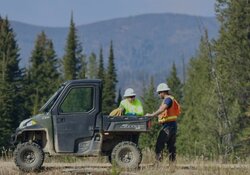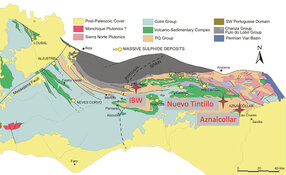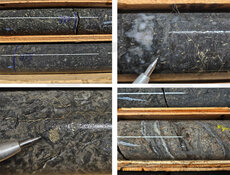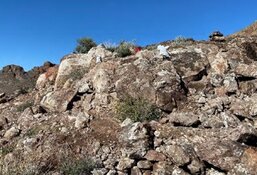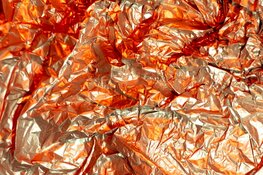Terence van der Hout: We were overweight in rare earths, which made us a lot richer in 2009 and 2010, but hurt us a lot more in 2011. Despite crashes, however, we still have a compound annual growth rate of 17% over the four years that we've been in existence.
We are an investment fund and we don't take short positions by principle. We take long equity positions in companies that we believe will excel. But that also means that we have to accept crashes as they occur. We still believe in rare earths. The downturn in 2011 provided us with a buying opportunity.
TCMR: About 80% of The Gold&Discovery Fund is in precious metals, while the other 20% is spread out among other commodities, like uranium, natural gas and rare earth elements (REE). Do the gold plays act as "secure investments" in the portfolio, while the rare earth and other commodity plays act as the growth component?
TVDH: Not necessarily, because a junior that makes a discovery is going to add value whether it's gold, uranium or rare earth-focused. Gold discoveries should be as much a part of our growth component as the REE or uranium juniors. Of course, the rare earths are subject to more cyclical market conditions than the strong fundamentals behind the gold markets.
TCMR: Rare earths are going through what is essentially the first sector down cycle because not many companies were in the space five years ago.
TVDH: That's true. Rare earths are a very different market. Takeovers are our sweet spot and gold juniors very quickly get from discovery to takeover if they are good enough. The market realizes that potential.
In the rare earths, it's somewhat of a different story. Companies often take more than five years to get to production. Success has a lot more work to do in the metallurgy. A lot more expertise is required. Takeovers, even for those rare earths that are in a fairly advanced stage now, are not imminent. Joint ventures with downstream end users may finance junior companies developing the deposits.
A number of companies in the rare earth sector should do well this year because they are at a stage where they will be able to show the world what their economics are like—and I think the world is hungry for more information about their true value.
TCMR: What are some items that could act as that trigger?
TVDH: Rare earths are subject to industrial production and general economic growth in emerging markets. China, India and Brazil need to continue growing. We believe that this will happen despite rising inflation in China and despite the west cautioning for a hard landing. Obviously, China has a virtual monopoly on the rare earth markets, but it will eventually need imported rare earths to keep the development path from going astray.
This may also be complemented by a return to normal industrial activity in Japan, which is one of the prime clients for heavy rare earths in the automotive and high-tech sectors. I expect that to gradually take place this year.
TCMR: Will China need more than it can produce on its own?
TVDH: There are different types of rare earths. China has plenty of the light rare earths, which are the more common and less expensive. However, it has few heavy rare earths. China does foresee shortages and has plans to begin importing more heavies.
TCMR: Rare earths are still not particularly well understood by investors. What myths about them would you like to dispel?
TVDH: There are misconceptions about the realities of supply and demand surrounding rare earths. Rare earths will continue to be indispensable in many high-tech applications. There will continue to be shortages, despite the current global economic downturn. That's a very important fundamental to realize. There has been a lot of talk about recycling and alternative sources for rare earths, which sends the message that there is no shortage of supply. A large number of applications in rare earths can't be substituted without a performance loss.
There are some recycling initiatives. However, the recycling initiatives that I've seen, for example, take magnets from the hard drives of computers that are often three years old and built to old specifications. Those magnets come with the performance of that time and the technology has moved on. That magnet might be obsolete. The magnet would probably need upgrading by adding dysprosium. If you're going to do that, you might need to re-melt and make a new alloy to produce a new magnet. That's not efficient or cheap. It might be cheaper in the end to just mine the stuff from the ground.
A lot of news stories talk about alternative sources of supply in Afghanistan, on the seabed, and even on the moon. These stories are more in the mythical sphere.
Rare earths also have incredible innovation potential. Their unique magnetic strength, connectivity, thermal capacity and resistivity to corrosion make them a prime focus for innovation. The potential of a technology discovery using these rare metals is about as large as it gets. We just don't know what the future demand is going to be. The chances of a new use for rare earths are quite real because of their unique characteristics.
TCMR: Is the key to adoption establishing a consistent supply at a relatively reasonable price?
TVDH: Exactly. Rare earths may run up to a few thousand dollars per kilogram, but if only a few grams are needed to make an alloy, it's only marginally more expensive from an end-product perspective. Scandium, for example, is alloyed with aluminum to get a very strong component that may replace composites for uses in the airline industry. Currently, scandium is about a 10–20 ton market. It's completely insignificant. But should the airline industry take off, it could explode. That is something that other rare metals have the potential for as well, which is quite exciting.
TCMR: What are some of the REE positions that you're bullish about?
TVDH: Recently, the term "critical rare earth oxides" has been introduced, which includes a number of the heavy rare earths, as well as neodymium. That aptly describes the type of company that we look for.
For example, Quest Rare Minerals Ltd. (QRM:TSX; QRM:NYSE.A) has a huge deposit in Québec that is endowed with a lot of heavy rare earths. It may have infrastructure issues and large capital expenditures (capex) to move on, but it has a lot of these critical rare earth oxides. It could be capable of providing several countries with a lasting supply of rare earths if it can show that its metallurgy is good and that it can extract the rare earths through a cost-effective method.
TCMR: Quest is putting together a preliminary economic assessment (PEA) on its Strange Lake deposit. Is a joint-venture partner likely for Quest?
TVDH: Joint-venture partners are cropping up on many of the more advanced projects. On the other hand, because Quest is so large, it may be one of the very few companies that a major could be interested in. That would be fairly unprecedented, however.
TCMR: What sort of catalyst do you think the PEA could be for the stock price?
TVDH: It could be a major catalyst if Quest can show in the pre-feasibility study (PFS), which is due in June, a reliable asset value or net present value (NPV). It could be $2 billion or a lot more–it's hard to say. It may surprise a lot of people. Let's put it that way.
TCMR: Is Quest an undervalued play relative to its peers right now? It certainly took a beating throughout the latter half of last year.
TVDH: Quest will probably need to supply about $1 billion in capex to get going. That may be a bit steep at this stage in comparison to other companies. Investors may be looking to see the other side of the equation. What are the revenues going to look like moving forward? What does the NPV look like? Once those unknowns are answered, I would expect it to be more fairly valued.
TCMR: What are some other REE plays you're into?
TVDH: Tasman Metals Ltd. (TSM:TSX.V; TAS:NYSE.A; TASXF:OTCPK; T61:FSE) holds a deposit that is smaller than Quest's, but has a higher distribution of heavy rare earths in Europe. It's conveniently close to the Molycorp Inc. (MCP:NYSE) processing facility in Estonia. You never know what kind of interest Molycorp may have in the future. It's convenient nonetheless.
TCMR: It also lowers the capex because it would only be shipping concentrate versus building a separation plant to refine all these different elements.
TVDH: Exactly. That will save a lot of money. Particularly since the distribution of heavy rare earths is so good.
TCMR: What sort of advantage is it for Tasman to have the only significant REE deposit in Europe?
TVDH: There is a concentration of high-tech and auto industries in Germany and Holland, which use rare earths in various magnets and catalytic converters. They have begun to organize into an interest group that is looking to secure its supply of rare earths. The Tasman deposit in Sweden represents a very obvious source for these industry actors, in my view. Rare earths are getting pretty politicized. Clearly, geography is becoming a very important aspect. This industry group might just help Tasman develop the deposit.
TCMR: The Swedish government obviously recognizes its importance and has already declared it to be a strategic national asset. Edward Otto, an analyst with Cormark Securities in Canada, has a buy rating with a $6 target on Tasman. Is that reasonable?
TVDH: Tasman just released metallurgy results that I view as part of its future flow sheet. The results are encouraging, but the company has a long way to go. It hasn't come to the last phase of delivering a heavy rare earth concentrate, which would be a saleable product.
TCMR: The average exceeded 90% in some cases.
TVDH: Yes, but that was recoveries into a concentrate that included zirconium, and lights and heavies into one concentrate–not separated concentrates. That last step was not in the last release. I think $6 is a nice target, but we'll have to see in the PFS, which is due shortly, whether it can come up with the separation at reasonable costs.
TCMR: Can the Estonia plant separate all the heavy rare earths?
TVDH: Not at this time. It initially processed almost exclusively light rare earths. It would need to do a lot of work before it could do anything with Tasman's ore.
TCMR: A recovery in the junior mining sector seems to be underway. Leading the way for The Gold&Discovery Fund is Rare Element Resources Ltd. (RES:TSX; REE:NYSE.A). It was up more than 123% in January after it indicated that it nearly doubled its REE deposit. Where does Rare Element go from here?
TVDH: The exciting aspect of Rare Element is that it is potentially a very low-cost producer in the U.S. where infrastructure is not going to be an issue. Molycorp and Lynas Corporation Ltd. (LYC:ASX) have plans to expand their production to higher levels of light rare earths. Rare Element is a light rare earth project as well, which at first glance would create some doubt as to its viability. However, Rare Element could be such a low-cost producer that it would be interesting for either Molycorp or Lynas, or as a standalone project.
TCMR: Are there other trends that are appealing to you?
TVDH: There was a recent development in the tantalum sphere, which implies that the U.S. Dodd-Frank Act mandates users of metals to prove they are conflict-free. A lot of tantalum is produced from the Democratic Republic of the Congo, which is obviously a conflict area. This act will put a lot of pressure on the supply side for tantalum. In addition to having a sizeable rare earth project, Commerce Resources Corp. (CCE:TSX.V; D7H:FSE; CMRZF:OTCQX) has a tantalum-niobium deposit in Canada. Its PEA shows positive economics.
TCMR: What are some of the things that tantalum is used for?
TVDH: Tantalum is used in consumer electronics, such as cell phones and computers. It's useful in products that are being designed to be small. Miniaturization is an innovative frontier that will require a lot more tantalum.
TCMR: Most of the news about Commerce is about its Eldor rare earth project in northern Québec. Do you think it might spin out the tantalum deposit into another company?
TVDH: It would be a logical step to find a suitor for the tantalum deposit because the company is now straddling two different markets. Tantalum and rare earths have different expertise and different dynamics.
TCMR: Does your fund have exposure to platinum group metals (PGMs)?
TVDH: PGMs hadn't appealed to us like the true precious metals, gold and silver, but platinum recently became very interesting. In South Africa, where about 75% of the world's platinum production originates, the African National Congress (ANC) recently announced a plan to allow the South African people to benefit more from the proceeds of the mining industry. This plan was more positive than we expected in a mining-sense, but it included nationalizing the platinum industry. If South Africans see platinum as a strategic sector, it could impact price, supply or both moving forward. It could make any non-South African platinum producer very interesting from an investment perspective.
We've looked briefly at Prophecy Platinum Corp. (NKL:TSX.V; PNIKD:OTCPK; P94P:FSE), which is based in the Yukon. It holds a fairly large deposit of decent-grade platinum along with palladium and rhodium. It has a PEA coming out soon. Should the ANC continue with its intentions of nationalizing platinum, we would be very interested in companies like Prophecy moving forward.
TCMR: Do you plan on getting in before the PEA is published by Prophecy or is the ANC issue not going to come fast enough for that?
TVDH: We are going to monitor the situation. It could be days or months before it becomes clear. If the ANC nationalization precedes the PEA, we'll consider an investment before the PEA. If it doesn't, we will have to wait.
TCMR: In addition to the PGMs, Prophecy looks to have about 2 billion pounds (Blb) of nickel and another 2Blb of copper. This could give the company a significant NPV. Is the base metal component critical to the play or are you mostly interested in the platinum?
TVDH: We are interested in the platinum. We have investments in copper and other base metal sectors already. However, the copper is a very nice asset, which would bring down the production and cash costs.
TCMR: You mentioned you like the true precious metals, gold and silver. What names there stand out to you?
TVDH: Wildcat Silver Corp. (WS:TSX.V) has a silver discovery in the U.S., which also contains large amounts of manganese. Manganese is typically added to steel for strength, but there have also been some recent innovations in the lithium-ion battery area that has opened up the commodity to innovation.
Looking at silver, we like Soltoro Ltd. (SOL:TSX.V), which has a silver discovery in Mexico. It has been very quick to expand its resources on its El Rayo property and moved up quickly to 78 million ounces of silver. The management is committed to doubling this during the course of the year. It has not drilled to any depth, which is interesting. It's gone to about 200m depth and moved on along strike. It's found a lot of different structures of mineralization. It may be able to find a lot more.
We're also involved with IAMGOLD Corp. (IMG:TSX; IAG:NYSE), which has a large gold asset, but is also a niobium producer.
Gold Canyon Resources Inc. (GCU:TSX.V), situated near the Red Lake District, has had some very nice holes of high-grade gold along parallel structures moving up to about a kilometer in length or more. The total resource now defined is 3.67 million gold ounces, and proves we made a right judgment in investing in them.
Finally, Newstrike Capital Inc. (NES:TSX.V) has the Ana Paula gold deposit in Mexico. This is a pretty similar high-grade, long intercept discovery that we like very much. Its resource estimate is due in the first half of this year. That was one of the companies that we jumped in immediately after its discovery in January 2011 because it was very significant. It's on strike with Goldcorp Inc. (G:TSX; GG:NYSE) and Torex Gold, two world-class, gold-silver deposits. There's a very good chance that it will come up with the goods as well.
These are the kind of discovery plays that we invest in and that we follow very closely.
TCMR: Thank you for your insights.
Terence van der Hout is a senior researcher at the Netherlands-based Gold&Discovery Fund. The fund focuses on investing in world-class natural resources discoveries in precious metals, base metals and specialty metals, as well as undervalued start-up producers. Terence also distributes Strategy Metals Bulletin, a free, bi-weekly commentary on developments in the world of critical metals. To subscribe, please send an email to: tvanderhout@zonnet.nl. Terence has a background in finance and holds a Master's of Administration in political science from the University of Leiden.
Want to read more exclusive Critical Metals Report articles like this? Sign up for our free e-newsletter, and you'll learn when new articles have been published. To see a list of recent interviews with industry analysts and commentators and learn more about critical metals companies, visit our Critical Metals Report page.
Disclosures
1) Brian Sylvester conducted this interview. I personally and/or my family own shares of the following companies mentioned in this interview: None.
2) The following companies mentioned in the interview are sponsors of The Critical Metals Report: Prophecy Platinum Corp., Quest Rare Minerals Ltd., Rare Element Resources Ltd., Tasman Metals Ltd., Goldcorp Inc., Newstrike Capital Inc., Gold Canyon Resources Inc. and Commerce Resources Corp.
3) Terence van der Hout: I personally and/or my family own shares of the following companies mentioned in this interview: Quest Rare Minerals Ltd. and Commerce Resources Corp. The Gold&Discovery Fund has positions in all the companies mentioned except for Prophecy Platinum, Molycorp, Lynas and Torex Gold.


